
Last Updated on 14/11/2022 by Above Diamond
Last Updated on 08/03/2022 by Wit Sudjaiampun
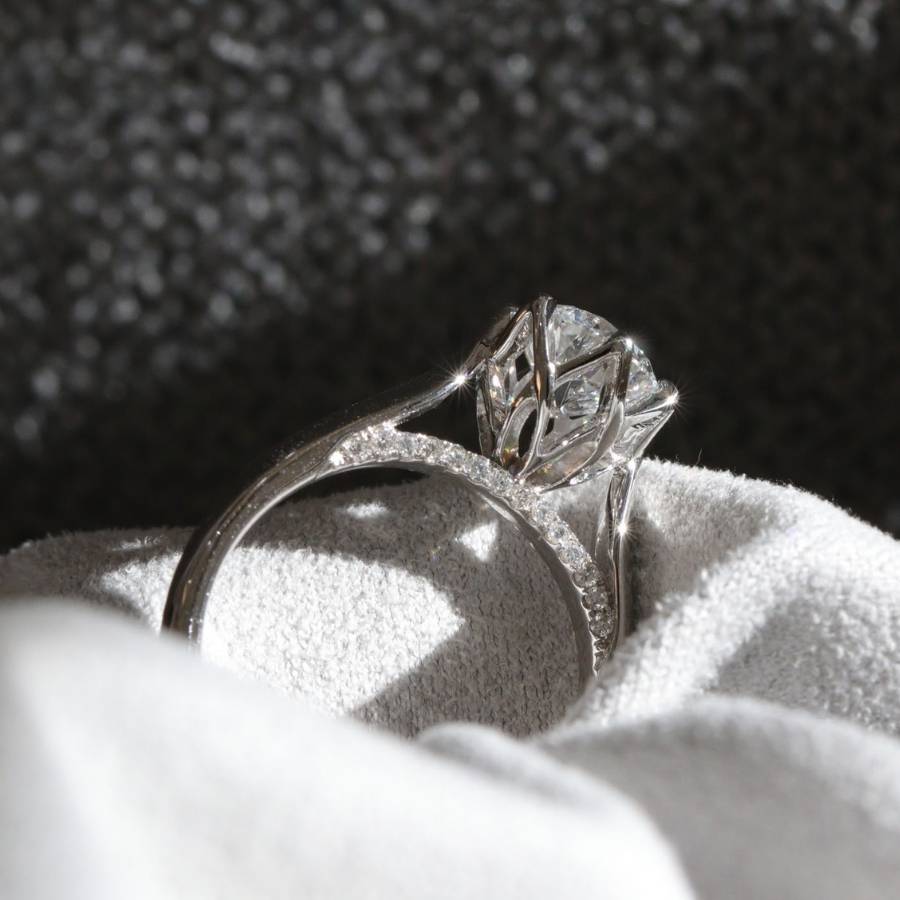
Selecting an engagement ring style or a wedding ring style is one of the most important steps you should take before pulling the trigger on ordering a custom diamond ring.
Have you ever felt the worry that comes with choosing an engagement ring or a wedding ring? There are so many styles for you to take a look at and they are everywhere – online, in magazines even in real life. The options are so vast that you may feel hesitant to choose one, the clash of choices feels almost as if you are charging into a major clothing sale.
What is worse than this…
Is that you may have also heard strange terms being thrown around about diamond setting techniques for each engagement ring styles, the terms could be prong setting, pave setting, channel setting, and much more. The more you hear of it, the more you are confused.
I know this because I was once in the same position as you.
And so I have written this article to explain to you in easy-to-understand terms what each type of engagement ring styles are, what they look like and what are their advantages and disadvantages.
Each type of engagement ring style you have seen before can be categorized as one of the 15 types of engagement ring styles that I will talk about today. I have also organized both the diamond setting techniques and the most popular engagement ring styles in this article, you will not need to waste your time elsewhere on the topic of engagement ring styles because I have gathered everything you need to know right here in this article.
And once you have selected an engagement ring style or a wedding ring style that you like, you can contact us so that we may help you in choosing the right ideal cut diamond for your ring.

A diamond ring style you will see most often and is considered as an eternal classic is the “Solitaire Style with Prong Setting”, this ring style is suited for lovers who are looking for an engagement ring style.
A “Prong Setting” is a type of ring setting that uses “prongs” to hold up a diamond or a gemstone, the ends of each prong are curved towards each other to hold the diamond up.
There are many types and shapes of prong settings: round, sharp, flat, or even “V” shaped (It is commonly used with the “Princess Cut Diamond”)
You will often see 4 or 6 prongs on most prong settings, the 4 prongs style being the more classic and popular option whilst the 6 is a more durable option.
This type of setting will make the diamond appear larger because the amount of metal holding it is minimal, you will be able to see the diamond from every angle – enabling the diamond to have a clear brilliant shine.
Most people who buy a 1 carat engagement ring will often use this engagement ring style.
Advantages of the Prong Setting
Disadvantages of the Prong Setting

Bezel setting engagement ring style is the second most popular because of its modern look that can accommodate for those with an active lifestyle.
This type of setting is different from the prong setting because instead of just gripping the diamond, the bezel setting will hold the entirety of the diamond with its thin circular bezel – this makes the diamond much more secure, similar to a thick phone case.
A bezel setting could surround every side of the diamond, or it could also leave out some parts to open the diamond up for viewing pleasures.
The bezel setting engagement ring style is suited for those who work with their hands because while working they will not have to worry if their ring will hook on to something or not.
Advantages of the Bezel Setting
Disadvantages of the Bezel Setting
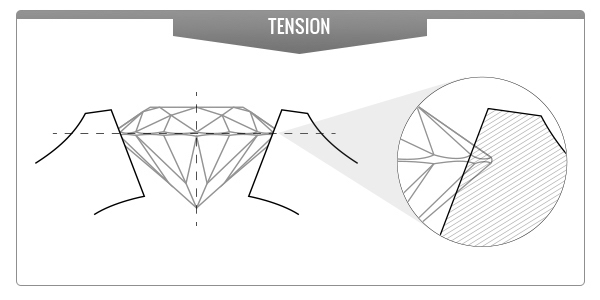
The classic tension setting refers to when the ring is held up by the pressure being exerted by the metal on two sides of the diamond. This makes the diamond appear as if it is held up just by the ring itself.
This makes your valuable diamond appear to be floating in the air from the pressure exerted by both sides of the ring, forcing your diamond to be stationary.
Advantages of the Classic Tension Setting
Disadvantages of the Classic Tension Setting
As for the tension-style bezel setting, it is designed to curve proportionally to the shape of the diamond. It is harder to create than the classic tension setting because it requires high expertise. This setting is also more protective than the classic tension setting and will have a more secure grip on the diamond.
This is a highly popular engagement ring style for those who like the classic tension setting because it lessens the flaws of the original by incorporating the use of bezels.
Advantages of the Tension-Style Bezel Setting
Disadvantages of the Tension-Style Bezel Setting
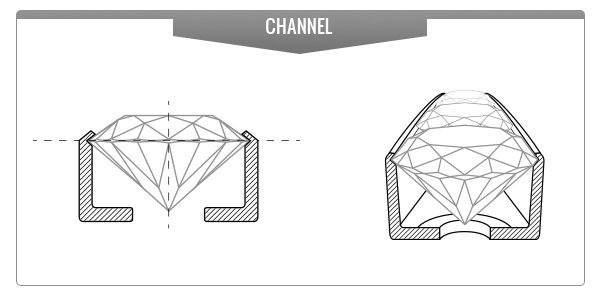
The channel setting is a safe way in setting smaller diamonds, the diamonds are arranged in a line with no metals barricading them from each other.
This type of setting is popular for diamond-row engagement ring styles, because of how the diamonds are arranged to curve around your finger – this diamond is highly received for the younger generations because it is easy to wear and is suitable for a daily life full of rush.
Because this ring setting does not use any prongs, it is appropriate for those who want safety and ease of wear.
Advantages of the Channel Setting
Disadvantages of the Channel Setting

The “Pavé” setting is a French word. In English, the word is “Pave” as in paving the way. In this case, it is paving the way for the diamonds.
This type of setting is fitting for grouping small diamonds together and then adhering them together with a small metallic sphere similar to caviar. This setting will make the diamonds appear incredibly full of sparkles and brilliance especially if placed onto a white gold engagement ring style.
Advantages of the Pavé Setting
Disadvantages of the Pavé Setting
I recommend you to select the correct ring size before ordering a custom ring with the engagement ring style you had in mind to protect yourself from the hassle of resizing the ring at a later date.
A halo setting ring refers to having a centerpiece diamond surrounded by smaller diamonds following the shape of the main diamond. This setting will make the centerpiece diamond appear larger,
This engagement ring style is a good option for showing your diamonds with the “all in” mentality. This setting also helps with the brilliance and sparkle of the diamond as well.
A halo setting diamond ring is fitting for those who want to save money because instead of buying a single large diamond, you can reduce the budget by buying smaller diamonds instead whilst also receiving an equally pleasing image.
More than this, if you choose to use fancy color diamonds or other gems as the centerpiece and then surround it with white diamonds as it gives the effect of complementary colors.
Halo settings are often used with the pave settings on the sides of the ring to increase its beauty, but even without the decorative pave setting – this setting still provides a minimalistic and tasteful engagement ring style.
Advantages of the Halo Setting
Disadvantages of the Halo Setting
The Cathedral Setting is considered as one of the most elegant and classic of all the engagement ring styles because of its base that raises the diamond, similar to an ancient Christian cathedral’s arch.
As for the setting method, the prong setting, the halo setting, or the tension setting could be used because the cathedral setting’s uniqueness does not come from its setting technique but its decorative approach in raising the diamond.
The cathedral setting will raise its diamond, making the diamond appear larger and more grand. This is considered a good method for those who have a limited budget because the ring emphasizes the patterns of the ring, rather than the number of diamonds on show.
Advantages of the Cathedral Setting
Disadvantages of the Cathedral Setting
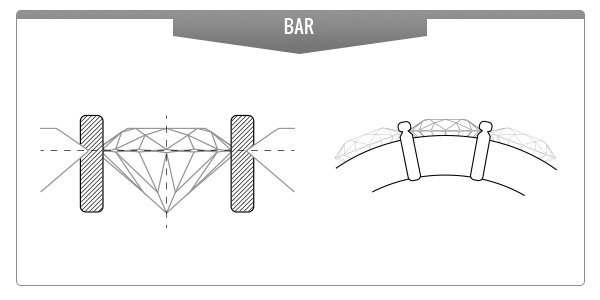
Setting the diamond with metal bars protruding from the ring is considered one of the more eye-catching ways to set diamonds because of its unique look.
The bar setting has some similarity to the channel setting but its difference lies in the space between the diamonds: the channel setting will leave no space between each diamond whereas the bar setting will leave some space between the diamonds for the metal bars to be inserted to hold each diamond in place.
This engagement ring style is great at emphasizing each diamond, making them stand out. It is suitable for making a wedding band or a set of stackable rings.
Advantages of the Bar Setting
Disadvantages of the Bar Setting
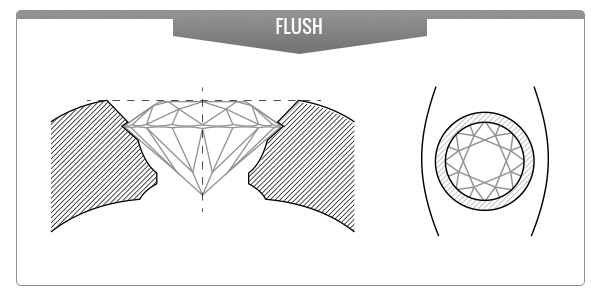
The Flush Setting, although it has a similar appearance to the bezel setting, has an appropriate name as the process of making this engagement ring style involves drilling a hole into a ring, placing a diamond inside it so that it is “flush” with the band of the ring, then the technicians will adjust the ring so that it grips onto the diamond securely.
This type of setting may not be suitable for gemstones that are more fragile than diamonds because they may break during the process of inserting the gemstone into the ring.
The flush setting is one of the firsts engagement ring styles that is mentioned when talking about men’s engagement rings styles because of the method the diamond is set, it is extremely unlikely that it will fall out.
Read more: 3 Tricks To Buying Men’s Wedding Rings To Surprise Your Special Someone!
Advantages of the Flush Setting
Disadvantages of the Flush Setting
Diamond-row engagement ring styles do not matter if it comes with 3, 4, 5, 6 or 7 diamonds. This is a very versatile engagement ring style and so it is often used as engagement rings, wedding rings, anniversary rings, or other special occasions.
As for the number of diamonds, it is up to the beliefs and contentment of the wearer.
For example, some may believe that 3 stone setting rings represent the past, the present, and a future that is full of partnership and love.
A 5 stone setting ring is popular in China because it believed that it will bring success to its wearer, and so it is appropriate as a symbol of a successful milestone in the wearer’s career.
Some may prefer to have more diamonds on their ring, and so they may choose the 7 stone setting because the number “7” (Lucky Seven) represents luck in Western beliefs.
Advantages of the Diamond-Row Rings
Disadvantages of the Diamond-Row Rings
Vintage engagement ring styles are vast. They are created to look like diamond rings from the past up to the renaissance period such as the Art Deco, Edwardian or Victorian styles. The focus is shifted towards the details and patterns of the ring instead.
If we were to talk about vintage diamond rings in Thailand, it could be said that they are just as outstanding as any other diamond rings from any country. Especially for the case of flower-shaped gold rings such as the Pikul Flower Rings (Bulletwood in English), or a ring style known for its sanctity of directly benefits its wearer – the “Noppakao Ring (Nine Gems Ring)”
Advantages of the Vintage Setting
Disadvantages of the Vintage Setting
The Cluster Setting engagement ring style refers to “clustering” the diamonds to make it appear as one single diamond. It can be made up of a large centerpiece diamond or it can entirely be made out of smaller diamonds.
This engagement ring style is suitable for those who wish to wear a large diamond ring but have a limited budget because investing in a single large diamond may be many times more costly than buying many smaller diamonds and then grouping them when compared to diamonds of the same quality.
Advantages of the Cluster Setting
Disadvantages of the Cluster Setting
An eternity band is a popular engagement ring style for women’s engagement rings, or other special occasions such as an anniversary, a birthday, or a Valentines Day.
It is called an “Eternity Band” because the diamonds are arranged in a circle, similar to the path of love in which the journey never ends – representing an immortal love that will last an eternity.
Advantages of the Eternity Band
Disadvantages of the Eternity Band
Shank setting engagement ring styles is a design that plays with the shanks of a ring. The shanks are separated into two parts which will converge at a point, the shanks are often decorated with round brilliant diamonds but if fancy diamonds are used – the already distinctive look will have a more powerful effect.
This engagement ring style is suited for those with slender fingers because it will help the wearer’s finger appear more full and proportional.
Advantages of the Shank Setting
Disadvantages of the Shank Setting
Additionally, if you want to accurately measure your ring size safely – we recommend you to use this ring size measurer which is made from Anodized Zinc Silver Alloy as it is more accurate the plastic version and will not cause irritation on your fingers like the other common alloys. The rings are perfectly round and will not hurt or cut your fingers.
Selecting the right engagement ring style is considered as one of the utmost importance, this decision should be made before all else because this is what will dictate the designs and the selection of the diamond.
As for the engagement ring style you choose, it is entirely up to your personal preferences or your personal lifestyle; for this part, only you will be able to decide.
One type of engagement ring style may be suitable for those who work with their hands often whilst another may be fit for those who have to attend social events frequently.
Another factor you should consider is taking care and cleaning your diamond ring to ensure that your ring always appears splendid and shining as it did on the first day. It does not matter which type of engagement ring style you choose, it will need to be cleaned one day. It is just that some styles are easier to clean than others.
Once you have settled on an engagement ring style you love or a wedding band you cannot keep off your mind, you should find a brilliant diamond that will best fit your ring. If you want us to help you hand-pick the sparkling diamond you always have had in mind, you can contact our expert to help you choose your perfect diamond ring.
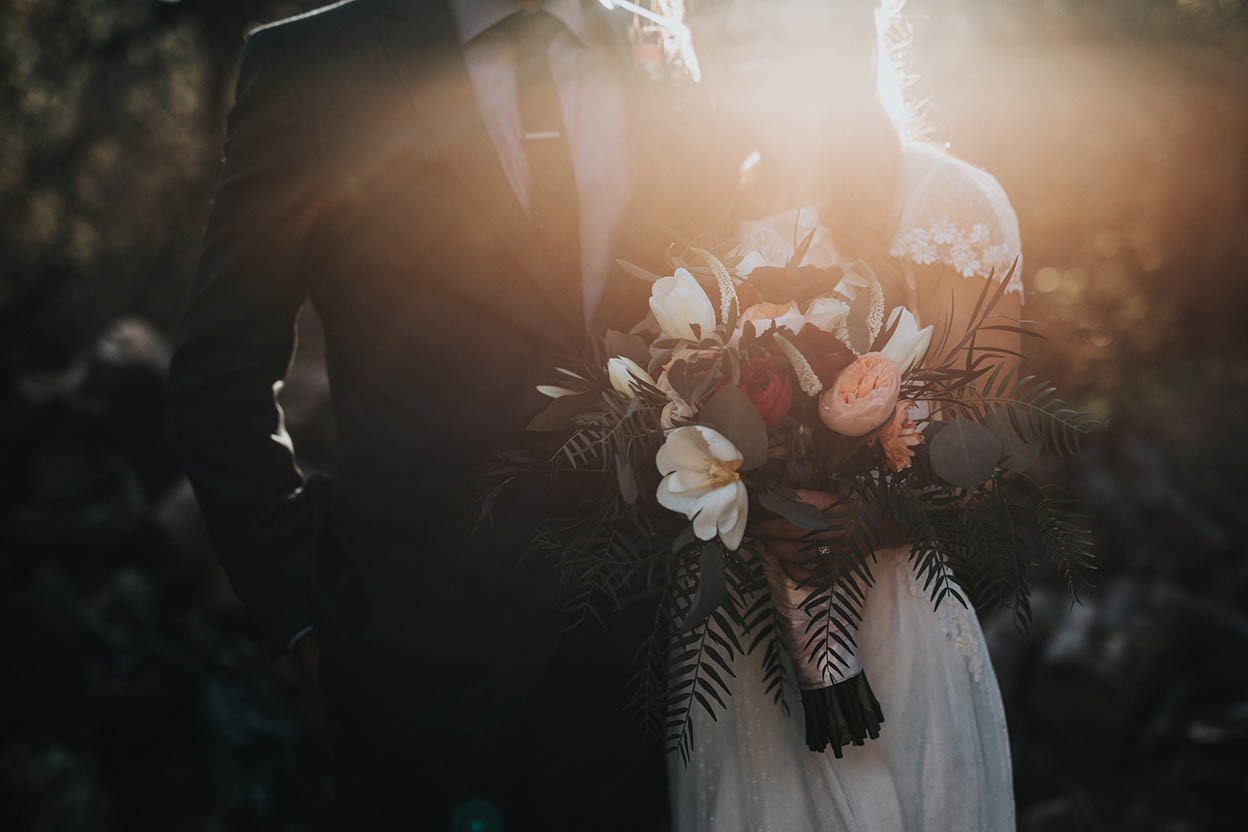
Get in touch with one of our diamond specialists.
This website use cookies to enhance your experience and providing the best service from us. You can learn more about our use of cookies in Privacy Policy